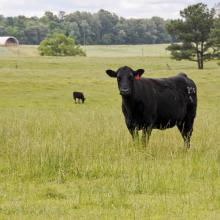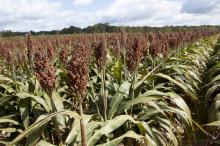Information Possibly Outdated
The information presented on this page was originally released on January 19, 2012. It may not be outdated, but please search our site for more current information. If you plan to quote or reference this information in a publication, please check with the Extension specialist or author before proceeding.
MSU research finds home on North and South Farms
MISSISSIPPI STATE – Untrained eyes see Mississippi State University’s extensive North and South Farm as typical farmland, but to researchers, these acres are their laboratories.
MSU has more than 2,200 acres of crop and pasture land adjacent to the Starkville campus. While commonly referred to as North and South Farms, these parcels of land are actually the R.R. Foil Research Center and the Leveck Animal Research Center, respectively.
North Farm cropland is divided into a variety of plot sizes so researchers can manipulate variables such as seed variety, fertilizer or herbicide application rates, irrigation, and disease and insect pressure. Plots are meticulously labeled and tracked, and some plants are individually labeled, making it possible for researchers to gather specific details.
Careful records are kept on livestock and horses on the South Farm. Special conditions can be created to allow animals to be managed and bred for highest performance and health.
“It is unusual for a land-grant institution to have research land this close to campus,” said Reuben Moore, associate director of the Mississippi Agricultural and Forestry Experiment Station. “Some forward-thinking previous administrators purchased this property. Many of our researchers also have teaching and Extension responsibilities, and these locations give them ready access from campus, making it easier to keep up with all their responsibilities.”
Work done at test plots on North and South Farm support MSU research in the Department of Plant and Soil Sciences, the Department of Biochemistry, Molecular Biology, Entomology and Plant Pathology, and the Department of Animal and Dairy Sciences.
Keith Daniels, superintendent of the two farms, said the land is dedicated completely to research.
“We have the largest land reserve adjacent to campus of any land-grant university in the country,” Daniels said. “We work with our researchers to provide the exact conditions they need to carry out projects. They state the land resource they need and what they’ll be doing, and we follow their protocols to accommodate their needs.”
North Farm is about 725 acres of row-crop land located north of Highway 182 on the northeast side of Starkville. It is a triangular-shaped piece of land bordered on the north by Highway 82 and the west by the Thad Cochran Research Park.
This highly visible stretch of farmland has about 400 acres of row crops, 180 acres of turf and ornamental plants, 75 acres of forest and about 190 miscellaneous acres dedicated to greenhouses, field labs and some outbuildings.
“About 25 percent of our operating budget each year is derived from row crop proceeds off North Farm,” Daniels said.
North Farm grows energy feed stocks, such as switch grasses, giant miscanthus and energy canes, to support a significant amount of bioenergy research.
South Farm is larger, encompassing about 1,500 acres on the southwest side of Starkville. Spring Street forms the east boundary of the land by the College of Veterinary Medicine, and the farm extends south to Poorhouse Road near the Starkville Country Club and west to residential areas along South Montgomery Street.
About 840 acres of this land are used for animal grazing and pasture projects, and 165 acres are used for hay. There are about 18 acres of aquaculture ponds and 500 acres of land in miscellaneous uses, including U.S. Department of Agriculture research and poultry science facilities.
While researchers set the conditions and stipulate each year what crops will be planted, how they will be managed, where animals will be grazed and what test conditions will be created, Daniels and his crew of eight make it happen.
“We have a few more workers than normal farms of this size have, but the work we do is labor intensive,” Daniels said. “The researchers tend to be very hands-on and do a lot of their own work with the help of graduate students and student labor, but there is a lot of work to be done on these acres.”
When researchers need more land than North and South Farm offers, research spills over to the Black Belt Experiment Station, about 25 miles away in Brooksville.
Moore said the research plots support projects funded by MSU, private industry contracts, USDA grants and other sources.
“For every dollar we get from state funds, we get about $1.30 from other sources,” Moore said.
One of those sources of funding is royalties from the ownership of intellectual property. Much of MSU’s research is in basic science, making discoveries about the composition of plants and animals, proteomics, genomics and genetics.
“We can look at positive characteristics, such as marbeling in beef or handling heat stress in livestock, and discover what genes are responsible for these desirable characteristics,” Moore said. “Or we can look for negative characteristics that are manifested, such as disease susceptibility, and try to determine what genes are responsible.”
Basic science forms the building blocks on which other, often commercially valuable, research is based. When a significant discovery is made or an important process developed, that knowledge can be legally protected as intellectual property. Rights to use this intellectual property are licensed to commercial interests, providing income for MSU that is put back into more research.
“One of our biggest recent research accomplishments on North Farm is the development of some highly successful, commercially available varieties of turfgrass,” Moore said. “We also were the first place in the world where there was field-sized testing of transgenic, or genetically engineered, cotton.”








